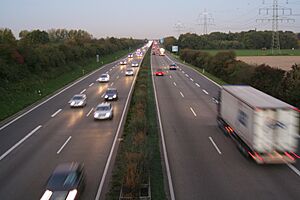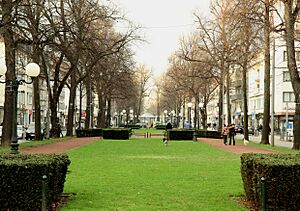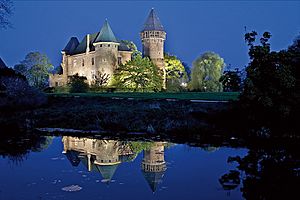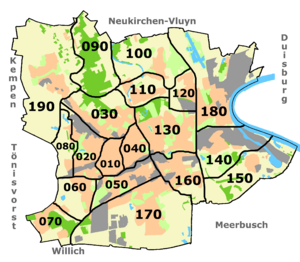Krefeld facts for kids
Quick facts for kids
Krefeld
Krieëvel (Limburgish)
|
|||
|---|---|---|---|

City Hall
|
|||
|
|||
| Country | Germany | ||
| State | North Rhine-Westphalia | ||
| Admin. region | Düsseldorf | ||
| District | Urban district | ||
| Elevation | 39 m (128 ft) | ||
| Population
(2022-12-31)
|
|||
| • Total | 228,426 | ||
| Time zone | CET/CEST (UTC+1/+2) | ||
| Postal codes |
47701-47839
|
||
| Dialling codes | 02151 | ||
| Vehicle registration | KR | ||
Krefeld is a city in North Rhine-Westphalia, Germany. It is located northwest of Düsseldorf, close to the Rhine river. The part of Krefeld called Uerdingen is right on the Rhine. Krefeld is often called the "Velvet and Silk City" because of its history in making these fabrics. You can reach Krefeld easily by the autobahns A57 and A44.
Most people in Krefeld today speak Standard German. However, the original local language is a type of Low Franconian called Krefelder Platt. A special language boundary line, called the Uerdingen line, runs through the Uerdingen area of Krefeld. This line helps show different dialect areas in Germany.
Contents
History of Krefeld
How Krefeld Began
The first time Krefeld was mentioned in records was in 1105. Back then, it was known as Krinvelde.
In 1598, Krefeld became part of the County of Moers. This area was given to Maurice, Prince of Orange. After 1601, Krefeld and Moers stayed under the control of the House of Orange and the Dutch Republic. This was during a time known as the Dutch Golden Age.
Krefeld was lucky because it avoided the terrible Thirty Years' War (1618–1648). However, the nearby town of Uerdingen was almost completely destroyed during this war. Uerdingen later became part of Krefeld.
Krefeld Joins Prussia
After William III of Orange died in 1702, Krefeld became part of the Kingdom of Prussia. A famous battle, the Battle of Krefeld, happened nearby in 1758 during the Seven Years' War.
In 1815, Krefeld and Uerdingen were included in the Prussian Rhine Province. Krefeld became an independent city in 1872.
During World War I in 1918, the Belgian Army used Krefeld as a base. In 1929, Krefeld and Uerdingen joined together and were called Krefeld-Uerdingen. In 1940, the name was shortened to just Krefeld.
Mennonites in Krefeld
Starting in 1607, Mennonites came to Krefeld. They were seeking safety from religious persecution in other areas. The House of Orange-Nassau, who ruled Krefeld, was more accepting.
In 1657, the Mennonite community was officially recognized. By 1693, they were allowed to build their own church. This church still exists today.
Some Mennonites from Krefeld, including thirteen families, left in 1683. They sailed on a ship called Concord to Pennsylvania in America. They wanted to find religious freedom there. They founded a settlement called Germantown, which is now part of Philadelphia. This group helped start the Pennsylvania Dutch ethnic identity.
A very important Mennonite family in Krefeld was the Von der Leyen family. They were famous for their silk businesses. By 1763, their factories employed half of Krefeld's population. Their home, built in 1791, is now the City Hall.
Jewish Community in Krefeld
Jewish people have lived in Krefeld since 1617. In 1764, a synagogue (a Jewish house of worship) was built. By 1812, there were 196 Jewish families in the town.
In 1846, a Jewish person was elected to the town council. A new reform synagogue was built in 1876. There was also a Jewish school with over 200 students around 1900.
During Kristallnacht in November 1938, the two synagogues in Krefeld were attacked. In 1941, Jewish people from Krefeld were sent away to the area around Riga and sadly murdered there.
After World War II in 1945, the U.S. Army took control of Krefeld. Henry Kissinger, who later became a famous U.S. Secretary of State, was in charge of the city's administration for a time.
In 2008, a new synagogue, library, and Jewish cultural center were built in Krefeld. About 1100 Jewish people lived in and around Krefeld at that time.
Krefeld During World War II
On December 11, 1941, during World War II, many Jewish people from Krefeld and Duisburg were sent to a place near Riga. They traveled in very cold conditions without water. Sadly, almost all of them were murdered soon after they arrived.
On June 21, 1943, British bombs caused a lot of damage to the eastern part of Krefeld. A huge fire destroyed much of the city center. On March 3, 1945, U.S. troops entered Krefeld.
After World War II, Krefeld became part of the new state of North Rhine-Westphalia.
Things to See in Krefeld
Krefeld has many interesting places to visit:
- Linn Castle: A historic castle.
- Botanischer Garten Krefeld: A beautiful public garden with many plants.
- Krefeld Zoo: A great place to see animals.
- Lange and Esters Houses: These are two houses designed by a famous architect, Mies van der Rohe. They are now used as a modern art museum.
- Kaiser Wilhelm Museum: Another museum for contemporary art.
- German Textile Museum: Learn about the history of textiles, especially silk and velvet.
- Galopprennbahn Krefeld: A horse racing track.
- The old towns of Uerdingen, Linn, and Hüls: These areas have kept their historic charm.
- Krefeld-Uerdingen Bridge: The only bridge that crosses the Rhine river in Krefeld.
Areas of Krefeld
Krefeld is divided into several districts. Each district has its own local representatives. Here are some of the districts:
- Stadtmitte (City Center)
- Kempener Feld/Baackeshof
- Inrath/Kliedbruch
- Cracau
- Dießem/Lehmheide
- Benrad-Süd
- Forstwald
- Benrad-Nord
- Hülser Berg
- Traar
- Verberg
- Gartenstadt
- Bockum
- Linn: This area has a long history, dating back to the 11th century. It has a Wasserburg, which is a castle built on water with a moat. The Burg Linn is now a park and museum.
- Gellep-Stratum
- Oppum
- Fischeln
- Uerdingen
- Hüls
How Krefeld Grew
Over the years, Krefeld has grown by including nearby towns and areas:
- 1901: Linn joined Krefeld.
- 1907: Bockum, Verberg, and Oppum joined.
- 1929: Krefeld became an independent city. It also merged with Uerdingen, Fischeln, Traar, Gellep and Stratum, Forstwald, and parts of Benrad and Hülserberg.
- 1975: The area of Hüls joined Krefeld.
Population of Krefeld
The number of people living in Krefeld has changed a lot over time. Here's a look at how the population has grown:
|
|
¹ These numbers come from official population counts.
Many people from different countries live in Krefeld. As of 2017, the largest groups of people from other countries were from:
| 7,805 | |
| 4,510 | |
| 2,610 | |
| 2,530 | |
| 2,225 | |
| 1,942 | |
| 1,386 | |
| 1,036 | |
| 872 | |
| 740 |
Getting Around Krefeld

Krefeld has good public transportation. You can travel by train using the Deutsche Bahn network. The main station is Krefeld Hauptbahnhof.
The Rheinbahn company runs a special train service called the Stadtbahn to Krefeld. This line, known as the K-Bahn, was one of the first electric inter-city train lines in Europe, started in 1898. Today, it's called U76.
Within Krefeld, the city has its own public transport company, SWK MOBIL. They operate four tram lines and many bus lines. Since 2010, Krefeld has been replacing older trams with new, modern ones that are easier for everyone to use. There are also plans to extend one of the tram lines to connect the northern part of Hüls with downtown Krefeld.
Krefeld's Economy
Krefeld is home to the main office of Fressnapf. This company is a large pet food retailer.
The Nirosta steelworks, a big steel factory, is also located in Krefeld. It used to be owned by ThyssenKrupp and was sold to Outokumpu in 2012.
Krefeld's International Connections
Since 1964, Krefeld has hosted a special program for high school students from Indiana, United States. About thirty students come to Krefeld each year to learn German and live with local families.
Since 1973, the fire services from Krefeld and its twin city Leicester in England play a friendly football match every year.
Krefeld's Twin Cities
Krefeld has "twin city" partnerships with several cities around the world. These partnerships help build friendships and understanding between different cultures.
 Venlo, Netherlands (1964)
Venlo, Netherlands (1964) Leicester, England, United Kingdom (1969)
Leicester, England, United Kingdom (1969) Dunkirk, France (1974)
Dunkirk, France (1974) Leiden, Netherlands (1974)
Leiden, Netherlands (1974) Charlotte, United States (1986)
Charlotte, United States (1986) Oder-Spree (district), Germany (1990)
Oder-Spree (district), Germany (1990) Ulyanovsk, Russia (1993) - This partnership is currently on hold due to recent events.
Ulyanovsk, Russia (1993) - This partnership is currently on hold due to recent events. Kayseri, Turkey (2009)
Kayseri, Turkey (2009) Kropyvnytskyi, Ukraine (2023)
Kropyvnytskyi, Ukraine (2023)
Famous People from Krefeld
Many notable people have come from Krefeld, including:
Scientists and Thinkers
- Charlotte Auerbach (1899–1994): A genetic scientist.
- Felix Kracht (1912–2002): An aerospace engineer and a pioneer of Airbus.
- Max Zorn (1906–1993): A mathematician.
- Rudi Dornbusch (1942–2002): A well-known economist.
Writers and Journalists
- Bernhard Hennen (born 1966): A writer of fantasy literature.
- Margarethe Schreinemakers (born 1958): A television presenter and journalist.
Musicians
- Andrea Berg (born 1966): A popular singer.
- Blind Guardian (formed 1984): A famous Power Metal band.
- Heinrich Band (1821–1860): He invented the musical instrument called the bandoneón.
- Ralf Hütter (born 1946): A leader of the electronic music band Kraftwerk.
Artists
- Joseph Beuys (1921–1986): A very influential artist.
- Johannes Itten (1888–1967): A Swiss painter and teacher.
Sportspeople
- Friedhelm Funkel (born 1953): A football manager and player.
- Philip Hindes (born 1992): A British sprint cyclist.
- Nicole Anyomi (born 2000): A football player.
Business Leaders
- Thierry Hermès (1801–1878): The founder of the famous French luxury brand Hermès.
Military Figures
- Werner Voss (1897–1917): A World War I aviator.
Politicians
- Jürgen Lenders (born 1966): A politician from the FDP party.
Mennonite Leaders
- Herman op den Graeff (1585-1642): A leader of the Mennonite community in Krefeld.
- Abraham op den Graeff (1646-1731): A grandchild of Herman, he was one of the first founders of Germantown, Pennsylvania. He also signed the first organized religious protest against slavery in America in 1688.
See also
 In Spanish: Krefeld para niños
In Spanish: Krefeld para niños






